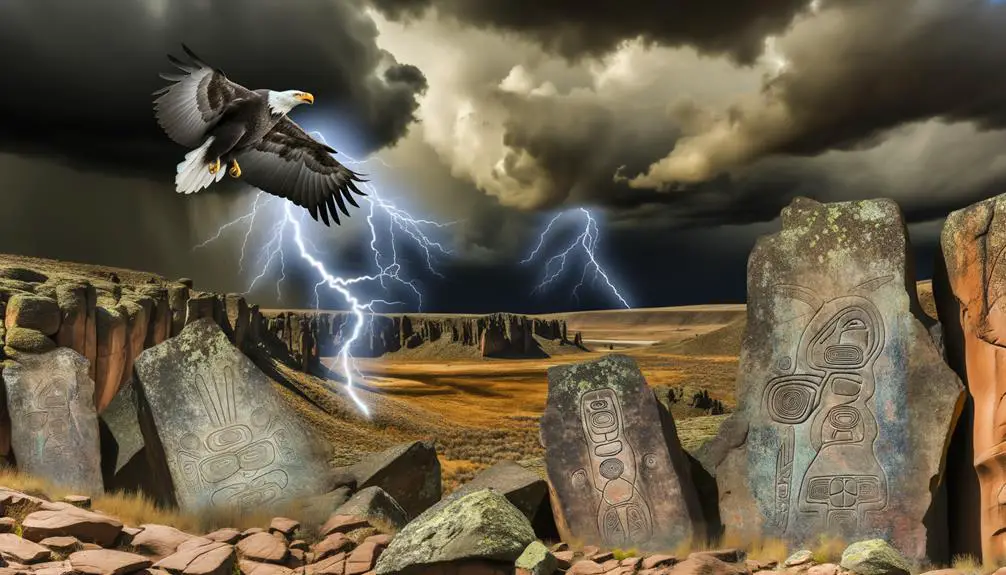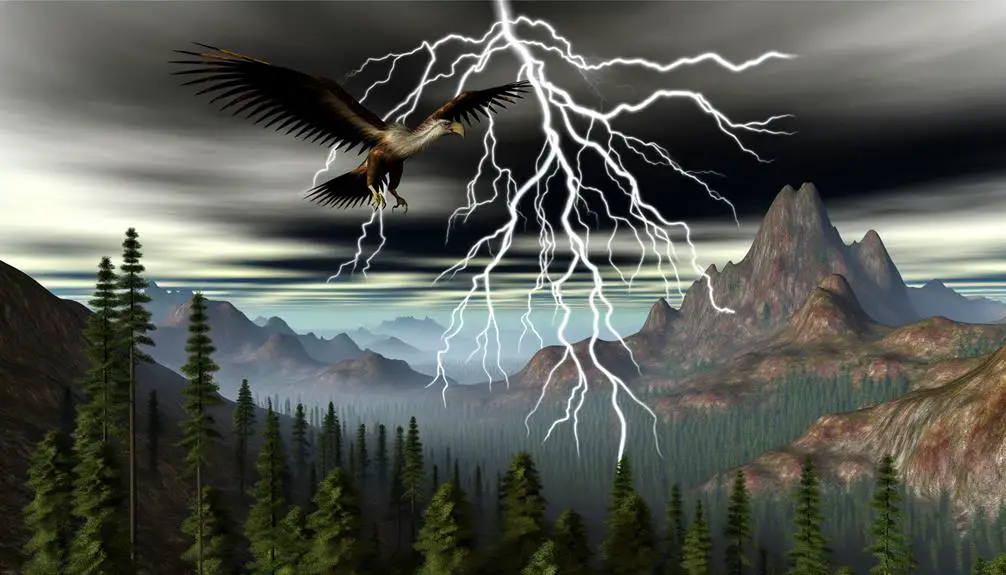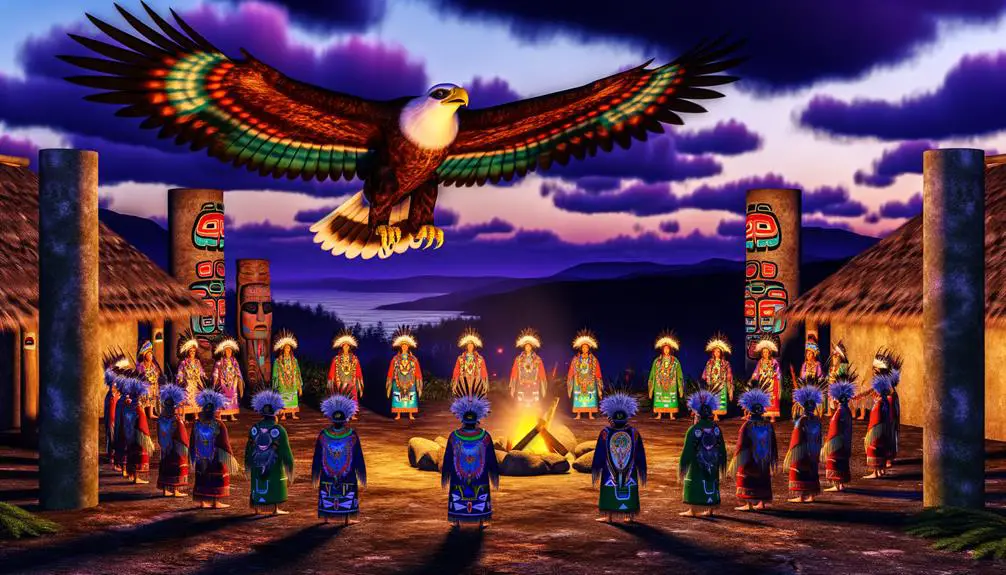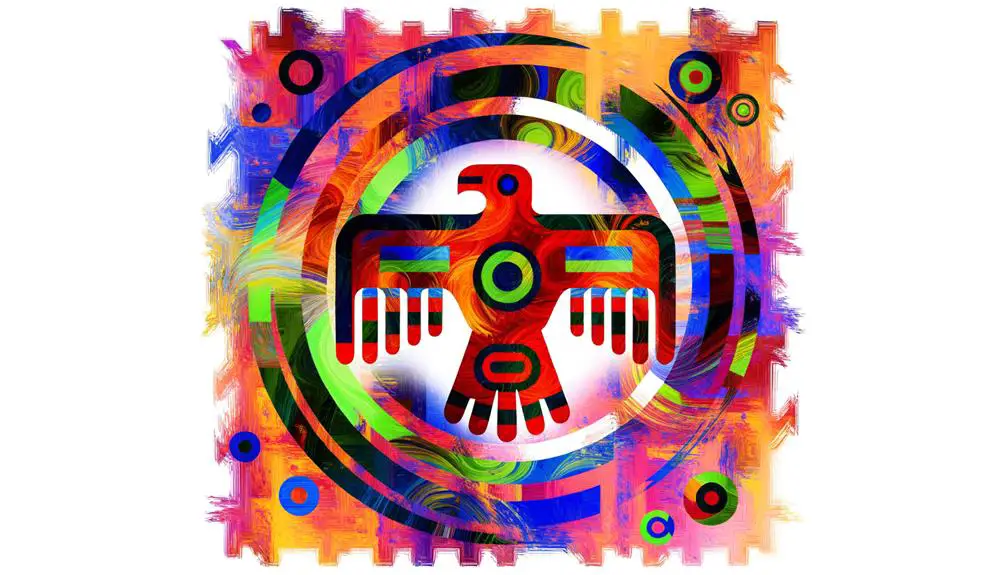Understanding the Native American Thunderbird Symbol Meaning
The Native American Thunderbird symbol represents a powerful and revered entity intrinsic to the spiritual and cultural traditions of numerous Indigenous tribes. Depicted as an enormous bird capable of controlling thunder, lightning, and rain, the Thunderbird is often seen as a protector against evil spirits and a guardian of the natural and spiritual worlds.
Each tribe, from the Plains to the Pacific Northwest, attributes unique symbolic meanings to the Thunderbird, which is prominently featured in art, ceremonies, and oral traditions. This symbol continues to hold significant cultural relevance today, seamlessly blending traditional narratives with modern interpretations.
Explore further to uncover its multifaceted significance.

Key Takeaways
- The Thunderbird is viewed as a divine entity controlling weather phenomena like thunder, rain, and lightning.
- It symbolizes protection and is believed to ward off malevolent spirits.
- Different tribes attribute unique spiritual meanings, from a sky spirit to a guardian figure.
- The Thunderbird represents power and is often depicted in Native American art and ceremonies.
- It holds significant cultural importance, embodying Indigenous heritage, strength, and spiritual guardianship.
Origins and Mythology

The origins and mythology of the Thunderbird symbol are deeply rooted in the rich oral traditions and spiritual beliefs of various Indigenous cultures across North America. This powerful supernatural being is often depicted as an enormous bird, wielding control over the elements, particularly thunder and lightning.
According to many Indigenous myths, the Thunderbird resides in the highest mountains and is a protector against evil spirits and adversities. Oral histories from tribes such as the Haida, Kwakwaka'wakw, and Lakota recount vivid stories of the Thunderbird's immense power and its role in maintaining natural and spiritual order.
These narratives emphasize the Thunderbird's revered status and its integral connection to the natural world, reflecting the profound respect these cultures hold for their environment and spiritual guardians.
Symbolism in Tribes
The thunderbird holds varied cultural significance across different Native American tribes, each attributing unique spiritual and symbolic meanings to the figure. These interpretations often manifest in diverse forms of tribal art and ritual, reflecting the thunderbird's multifaceted role within their spiritual frameworks.
Understanding these variations is crucial for a thorough appreciation of the symbol's depth and complexity.
Cultural Significance Variations
Across various Native American tribes, the Thunderbird symbol holds diverse and profound meanings that reflect each tribe's unique cultural heritage and cosmology.
For the Plains tribes, such as the Sioux, the Thunderbird is often seen as a powerful sky spirit capable of creating storms and providing rain for crops.
In the Pacific Northwest, tribes like the Haida and Kwakwaka'wakw depict the Thunderbird as a guardian figure, integral to totem pole designs and clan identities.
The Algonquin people view the Thunderbird as a protector against malevolent spirits. These variations illustrate how the Thunderbird embodies multifaceted roles, from a weather deity to a guardian, each rooted in the specific environmental and spiritual contexts of the tribes.
Spiritual Representations
Frequently revered within their communities, the Thunderbird symbol in Native American tribes often embodies profound spiritual significance, representing divine power, protection, and the embodiment of natural forces. This mythical creature is central to various tribal spiritual beliefs, serving as a bridge between the earthly and the divine.
| Tribe | Spiritual Meaning | Key Attributes |
|---|---|---|
| Lakota | Divine Messenger | Power, Strength |
| Kwakwaka'wakw | Guardian Spirit | Wisdom, Protection |
| Algonquin | Creator of Thunder and Storms | Natural Forces, Energy |
| Ojibwe | Sacred Being | Transformation, Renewal |
| Haida | Supernatural Entity | Leadership, Control of Weather |
The Thunderbird's role varies among tribes but consistently underscores a connection to the spirit world, reinforcing its revered status in Native American culture.
Tribal Artistic Depictions
Many Native American tribes integrate the Thunderbird symbol into their artistic practices, reflecting its profound cultural and spiritual significance through intricate carvings, paintings, and textiles.
For example, in the Pacific Northwest, the Haida and Tlingit tribes often depict the Thunderbird in totem poles, symbolizing power and protection.
The Ojibwe, found in the Great Lakes region, incorporate Thunderbird imagery in their beadwork and ceremonial regalia, representing strength and divine intervention.
The Pueblo tribes of the Southwest frequently illustrate the Thunderbird in pottery and woven blankets, signifying rain and agricultural fertility.
These artistic depictions not only showcase the Thunderbird's revered status but also preserve and convey the rich oral histories and traditions of each tribe, fostering a deeper connection to their ancestral heritage.
Thunderbird and Weather

The Thunderbird is often regarded as a powerful force of nature, intrinsically linked to weather phenomena such as storms and lightning in various Native American cultures. This mythical creature is believed to possess the ability to control the elements, summoning thunder, rain, and wind with the flapping of its enormous wings.
In many tribes, including the Sioux and Algonquian peoples, the Thunderbird is viewed as a divine entity that both nurtures and purifies the earth. Its presence is often invoked during times of drought or to ward off malevolent spirits.
The reverence for the Thunderbird underscores the profound relationship between these communities and the natural world, reflecting a deep understanding of and respect for the forces that shape their environment.
Depictions in Art
Artists from various Native American tribes have meticulously depicted the Thunderbird in a myriad of forms, ranging from intricate beadwork to monumental totem poles, each representation imbued with profound cultural significance.
The Thunderbird often appears with outstretched wings, symbolizing power and protection, and is sometimes accompanied by lightning and rain motifs, reflecting its association with weather. Plains tribes, such as the Lakota, frequently incorporate the Thunderbird into vibrant quillwork and painted hides, while Pacific Northwest tribes, like the Haida and Tlingit, carve elaborate Thunderbird figures into totem poles and ceremonial artifacts.
These artistic depictions serve not only as aesthetic expressions but also as essential channels for transmitting spiritual beliefs and historical narratives, reinforcing the Thunderbird's integral role in Native American culture.
Ceremonial Roles

Integral to numerous Native American ceremonies, the Thunderbird often serves as a powerful spiritual symbol and guardian. This mythical bird is revered for its association with thunder, lightning, and rain, elements vital to agricultural cycles and the sustenance of life. Its ceremonial roles encompass various aspects of Native American cultural and spiritual practices:
- Rainmaking Rituals: Invoking the Thunderbird to bring rain, essential for crop growth and survival.
- Protection Ceremonies: Calling upon the Thunderbird to ward off malevolent spirits and safeguard the community.
- Initiation Rites: Symbolizing transformation and strength, the Thunderbird is integral in rites of passage, marking significant life stages.
These ceremonious invocations underscore the Thunderbird's profound significance within Native American spiritual and cultural frameworks.
Tales and Legends
Exploring the rich tapestry of Native American folklore, tales and legends of the Thunderbird reveal its role as a significant and sacred entity imbued with immense power and wisdom.
Among the various tribes, the Thunderbird is often depicted as a colossal bird whose wings create thunder and whose eyes emit lightning. In many narratives, it serves as a protector of humans against malevolent spirits and natural disasters. The Thunderbird is also seen as a harbinger of storms, symbolizing both creation and destruction.
Tribes such as the Sioux, Algonquin, and Haida recount stories where the Thunderbird plays an essential role in maintaining cosmic balance, emphasizing its revered status within their cultural and spiritual frameworks.
Modern Interpretations

In contemporary society, the Thunderbird symbol continues to hold significant cultural meaning, often representing power, protection, and spiritual wisdom.
Artistic representations today frequently draw from traditional motifs while incorporating modern elements, reflecting an evolving yet respectful engagement with Indigenous heritage.
Additionally, the Thunderbird's symbolism has found its way into modern media, where it often serves to underscore themes of strength and resilience.
Contemporary Cultural Significance
The contemporary cultural significance of the Thunderbird symbol among Native American communities reflects a blend of historical reverence and modern reinterpretations. This iconic figure continues to resonate deeply for several reasons:
- Cultural Identity: The Thunderbird serves as a powerful emblem of indigenous heritage and pride, often featured in ceremonies and gatherings to reaffirm communal bonds.
- Spiritual Symbolism: Modern Native Americans still regard the Thunderbird as a spiritual protector, embodying strength and divine oversight in a rapidly changing world.
- Educational Tool: The symbol is utilized in educational programs to teach younger generations about their history, instilling a sense of continuity and respect for ancestral wisdom.
These aspects underscore the enduring relevance of the Thunderbird in contemporary Native American life.
Artistic Representations Today
Modern interpretations of the Thunderbird symbol in Native American art showcase a dynamic blend of traditional motifs and contemporary artistic expression.
Artists today draw from the rich cultural heritage of the Thunderbird, incorporating its storied symbolism into diverse mediums such as painting, sculpture, and digital art.
This fusion not only preserves ancestral narratives but also allows for innovative reinterpretations that resonate with modern audiences.
The use of bold colors, intricate patterns, and abstract forms serves to both honor and evolve the Thunderbird's legacy.
Importantly, these artistic endeavors are undertaken with a deep respect for tribal traditions, ensuring that the Thunderbird remains a powerful emblem of strength, protection, and spiritual significance in today's cultural landscape.
Symbolism in Modern Media
Beyond artistic representations, the Thunderbird symbol has permeated modern media, appearing in films, television, literature, and video games as a powerful icon that bridges traditional narratives with contemporary storytelling. This cross-cultural symbol's significance is often depicted with a mix of reverence and creative interpretation, reflecting its deep-rooted heritage and enduring allure.
- Films and Television:
Numerous productions have incorporated the Thunderbird, portraying it as a mystical creature embodying strength and protection.
- Literature:
Authors frequently use the Thunderbird as a metaphor for transformation and power, drawing on its rich symbolism.
- Video Games:
The Thunderbird often appears as a powerful entity or guardian, enhancing gameplay with its mythic attributes.
These modern interpretations continue to honor and evolve the Thunderbird's legacy.
Spiritual Significance
In various Native American cultures, the Thunderbird holds profound spiritual significance, symbolizing power, protection, and a connection to the divine. This majestic being is often seen as a guardian spirit, its mighty wings producing thunder, and its eyes flashing lightning.
The Thunderbird is believed to be a mediator between the physical world and the spiritual domain, embodying the sacred forces of nature. Among the Plains tribes, the Thunderbird is a revered figure in ceremonial practices, while the Pacific Northwest tribes depict it in totem poles, emphasizing its role in creation myths.
Its presence in rituals and folklore underscores its importance in maintaining cosmic balance and fostering a deep, spiritual bond with the natural world.
Conclusion
The thunderbird, a majestic emblem soaring through the annals of Native American culture, encapsulates profound spiritual significance, meteorological power, and artistic inspiration.
Its presence in mythology, ceremonial roles, and tribal symbolism underscores a deep connection to nature and the cosmos.
Modern interpretations continue to honor this revered icon, weaving its legacy into contemporary narratives.
Consequently, the thunderbird remains a powerful indication of the enduring spirit and rich cultural tapestry of Native American heritage.






